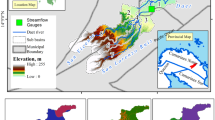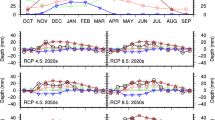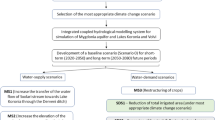Abstract
Climate change impacts and potential adaptation strategies were assessed using an application of the Water Evaluation and Planning (WEAP) system developed for the Sacramento River basin and Delta export region of the San Joaquin Valley. WEAP is an integrated rainfall/runoff, water resources systems modeling framework that can be forced directly from time series of climatic input to estimate water supplies (watershed runoff) and demands (crop evapotranspiration). We applied the model to evaluate the hydrologic implications of 12 climate change scenarios as well as the water management ramifications of the implied hydrologic changes. In addition to evaluating the impacts of climate change with current operations, the model also assessed the impacts of changing agricultural management strategies in response to a changing climate. These adaptation strategies included improvements in irrigation technology and shifts in cropping patterns towards higher valued crops. Model simulations suggested that increasing agricultural demand under climate change brought on by increasing temperature will place additional stress on the water system, such that some water users will experience a decrease in water supply reliability. The study indicated that adaptation strategies may ease the burden on the water management system. However, offsetting water demands through these approaches will not be enough to fully combat the impacts of climate change on water management. To adequately address the impacts of climate change, adaptation strategies will have to include fundamental changes in the ways in which the water management system is operated.









Similar content being viewed by others
Notes
The Sacramento Valley 40-30-30 Water Year Hydrological Index is equal to 0.4 x current April to July unimpaired runoff + 0.3 x current October to March unimpaired runoff + 0.3 x previous year’s index (if the previous year’s index exceeds 10.0, then 10.0 is used).
References
California Climate Change Center. 2006. Our changing climate: Assessing the risks to California. A summary report from the California Climate Change Center. CEC-500-2006-077.
California Environmental Protection Agency. 2006. Climate Action Team Report to Governor Schwarzenegger and the Legislature. Sacramento, California. www.climatechange.ca.gov/climate_action_team/reports/index.html.
Cayan, D., Luers, A., Hanemann, M., Franco, G. 2006. Scenarios of climate change in California: an overview. White paper for the California Climate Change Center. CEC-500-2005-186-SF.
Cayan, D., Tyree, M., Dettinger, M., Hidalgo, H., Das, T., Maurer, E., Bromirski, P., Graham, N., and Flick, R. 2009. Climate change scenarios and sea level rise estimates for the California 2009 climate change scenarios assessment. White paper for the California Climate Change Center. CEC-500-2009-014-F.
Chung, F., Anderson, J., Aurora, S., Ejeta, M., Galef, J., Kadir, T., Kao, K., Olson, A., Quan, C., Reyes, E., Roos, M., Seneviratne, S., Wang, J., and Yin., H. 2009. Using future climate projections to support water resources decision making in California. White paper for the California Climate Change Center. CEC-500-2009-052-F
Joyce, B., S. Vicuna, L. Dale, J. Dracup, M. Hanemann, D. Purkey, and D. Yates. 2006. Climate change impacts on water for agriculture in California: A case study in the Sacramento Valley. White paper for the California Climate Change Center. CEC-500-2005-194-SD.
Luers, A.L., D.R. Cayan, G. Franco, M.W. Hanemann, and B. Croes. 2006. Our changing climate: Assessing the risks to California. White paper for the California Climate Change Center. CEC-500-2006-077.
Maurer E, Wood A, Adam J, Lettenmaier D, Nijsee B (2002) A long-term hydrologically-based data set of land surface fluxes and states for the conterminous United States. J Climate 15:3237–3251
Nakicenovic, N., and R. Swart. 2000. Special Report on Emissions Scenarios. Intergovernmental Panel on Climate Change.
Moser, S., G. Franco, S. Pittiglio, W. Chou, and D.R. Cayan. 2009. The future is now: An update on climate change science impacts and response options for California. White paper for the California Climate Change Center. CEC-500-2008-071.
Purkey DR, Joyce BA, Vicuna S, Hanemann MW, Dale LL, Yates D, Dracup JA (2008) Robust analysis of future climate change impacts on water for agriculture and other sectors: A case study in the Sacramento Valley. Climatic Change 87(suppl 1):S109–S122
State Water Resources Control Board. 1995. Water quality control plan for the San Francisco Bay/Sacramento-San Joaquin Delta Estuary. 95–1 WR. May 1995. California Environmental Protection Agency. Sacramento, California.
Yates D, Sieber J, Purkey D, Huber Lee A (2005a) WEAP21: A demand, priority, and preference driven water planning model: Part 1, model characteristics. Water International 30:487–500
Yates D, Sieber J, Purkey D, Huber Lee A, Galbraith H (2005b) WEAP21: A demand, priority, and preference driven water planning model: Part 2, Aiding freshwater ecosystem service evaluation. Water International 30:501–512
Yates D, Purkey D, Sieber J, Huber-Lee A, Galbraith H, West J, Herrod-Julius S, Young C, Joyce BA, MAl Raey (2009) A climate-driven water resources model of the Sacramento Basin, California USA using WEAP21. ASCE J Wat Res Management 135(5):303–313
Author information
Authors and Affiliations
Corresponding author
Electronic Supplementary Materials
Below is the link to the electronic supplementary material.
ESM 1
(DOCX 677 kb)
Rights and permissions
About this article
Cite this article
Joyce, B.A., Mehta, V.K., Purkey, D.R. et al. Modifying agricultural water management to adapt to climate change in California’s central valley. Climatic Change 109 (Suppl 1), 299–316 (2011). https://doi.org/10.1007/s10584-011-0335-y
Received:
Accepted:
Published:
Issue Date:
DOI: https://doi.org/10.1007/s10584-011-0335-y




